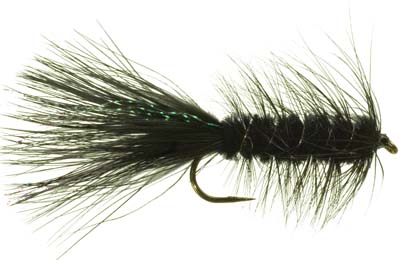
Russell Blessing’s Woolly Bugger Skip Clement, New Zealand.
Russell Blessing’s Woolly Bugger, the best fly ever invented?
Of the many angling memories I have – a serendipitous meet-up with Russell Blessing on the Juniata in Pennsylvania tops all of them.
With a quick count, Google and YouTube, there are over 157 Woolly Bugger tying instructions or variations of the classic Woolly Bugger developed by Pennsylvania angler and fly tyer Russell Blessing.
One rule that has held water in my circle of friends since the invention in 1967 is using black or black, and creating from there, is the best bet, by far. An all-black woolly, any variety, is the most profitable fish catcher for big brook trout ever invented, no matter their lair. The only place unverifiable as sure-fire is catching small, hand-size mountain stream brookies, but if a betting person, a #16- to #18-black woolly would be a good call.
How many fish species have you caught on a Woolly Bugger? Well, we can list everything from carp to tarpon here. Sure, there are many variations of ties as in colors, sizes, material and hook choices. One thing for sure – a WB catches fish. My interest was heightened because I fished the water referred to in the following interview many, many times.
Russell Blessing Remembered
By Fly Rod and Reel / Kirk Werner / Editor’s Pick
The late Russell Blessing probably helped you catch a bunch of fish. The man who created the Woolly Bugger never sought to become a household name, but his invention has attained a heralded status among fly anglers worldwide. What follows is a brief interview with Russ’s son, Fred Blessing, as he remembers the man behind the fly that has helped anglers worldwide catch more fish than perhaps any other pattern.
Q: Your father, Russ Blessing, is credited with having invented the Woolly Bugger. How and when did he arrive at this invention?
A: When he created the fly in 1967, he wasn’t an avid fly tier like he was in his later years. He actually created it for smallmouth bass. He wanted to create something similar to the Dobsonfly larvae, later added a marabou tail, which created the Woolly Bugger.
How different was the first Russell Blessing’s Woolly Bugger than what we typically see today?
A: There are so many different patterns and colors today, but to me the original Woolly Bugger had olive chenille body, black hackle and marabou tail. Dad always believed that the more movement in the water from the hackle and tail the better. His Buggers always looked that way.
Woolly Bugger is a curious name. Can you tell us how Russ came to call it that?
A: (Grin) My sister Julie named it when she was 7. She saw the fly and said, “ It looks like a Woolly Bugger.”
 Q: The Woolly Bugger has become very widely known, well beyond the boundaries of North America. How was your father able to so effectively promote the pattern?
Q: The Woolly Bugger has become very widely known, well beyond the boundaries of North America. How was your father able to so effectively promote the pattern?
A: In August 1967, Dad was fishing the Little Lehigh. Barry Beck was fishing downstream and wasn’t having any luck, like everyone else that day. Dad landed a nice trout, then another. Barry approached him out of curiosity and Dad gave him a Woolly Bugger to try. Barry started catching trout. They later became friends and Barry did an article on the fly in 1984. It became well known after that. Dad never wanted to promote the fly; he just wanted to catch fish. He was very humble about his creation.
The Russell Blessing’s Woolly Bugger is known to be very effective on a wide variety of gamefish. What species did your father most often fish for?
A: Early on he fished a lot for smallmouth bass; he just loved to fish. Even in his younger years, he would fish with bait. Once he got more involved with fly fishing and tying flies, he then really started getting into fishing for trout.
Where was his favorite fishing destination?
A: He had a few favorite spots. One was only a few miles from his home, Manada Creek outside of Harrisburg, PA. He would even fish there in the winter if weather permitted, on the regulated sections. His favorite had to be spending time in upstate PA fishing with his friend Dutch. Sorry, I wont give that location away (grin). Dad pretty much stayed local.
Q: The legacy of the Woolly Bugger will likely last as long as there are fish to be caught. What would your late father most like to be remembered for?
A: First, that he was a dedicated family man, a man of strong faith, someone who was generous, honest…I could go on and on. That’s why we all miss him so much. He never wanted recognition for inventing the Woolly Bugger—he was just happy he created something that could give a fly fisherman an opportunity to catch some fish. Second, that he was a pretty darn good fly fisherman.
Kirk Werner is the author of Olive the Little Woolly Bugger and [Olive and The Big Stream, and Olive Goes for a Wild Ride]. Russ Blessing was Fly Rod & Reel’s “Angler of the Year” in 2006. Amazon – find the Woolly in: Fly Tying: 30 Years of Tips, Tricks, Patterns . . .
NOTE: Fly Rod & Reel is no longer in business.



Join the discussion 2 Comments